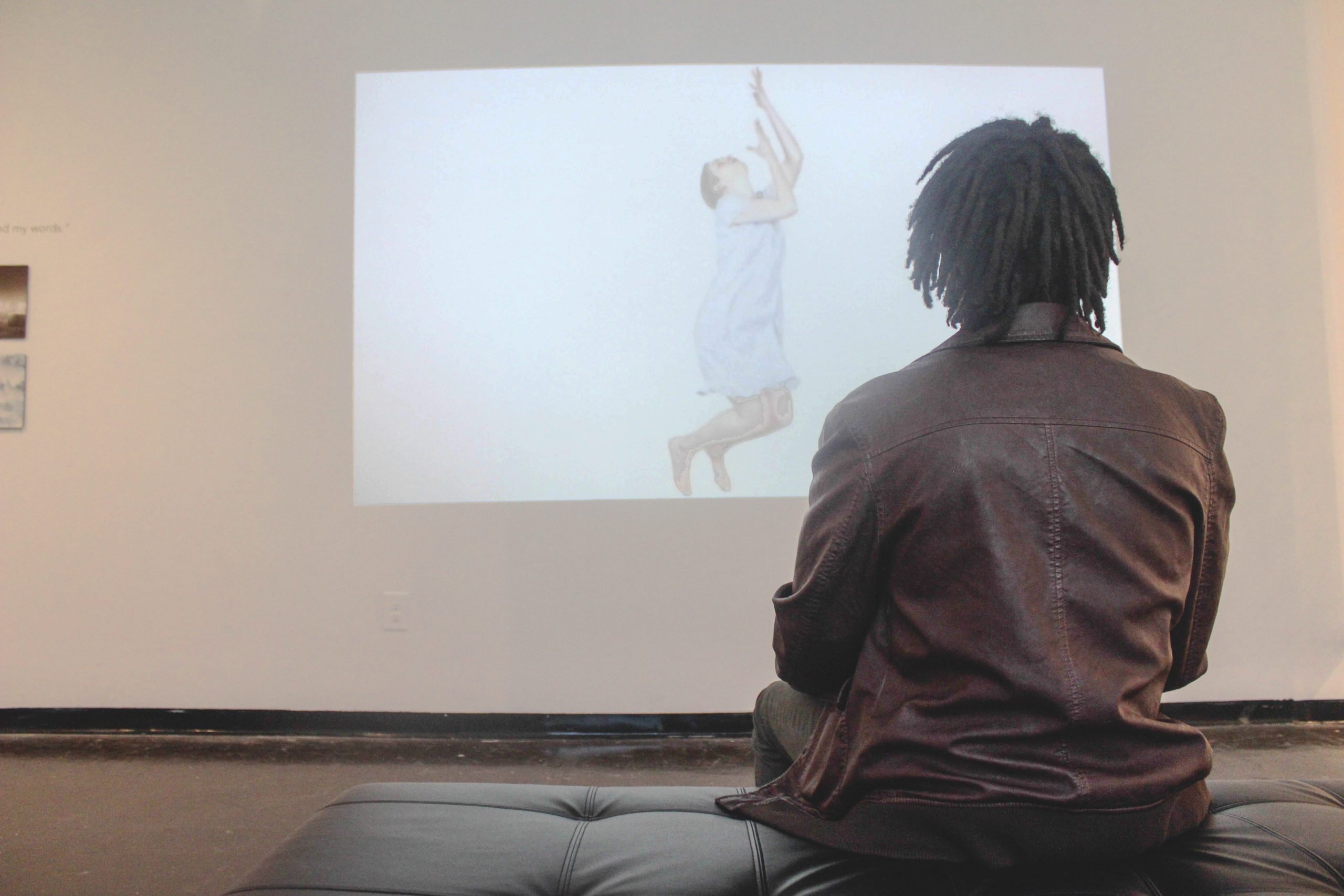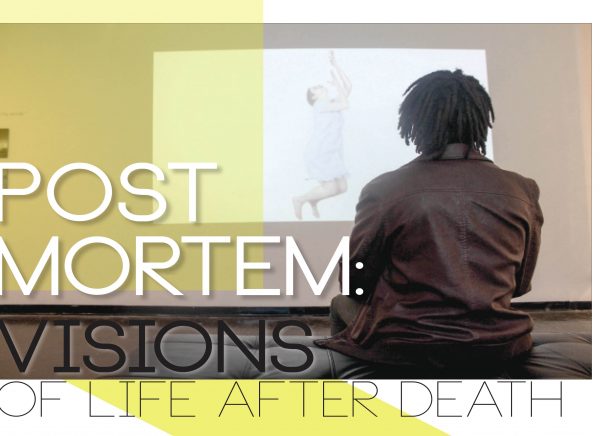

Life after death is housed in the Georgia State Arts and Humanities building in the form of the Post Mortem gallery.
White sheets of cotton hang from the ceiling, separating the space into three sections. Videos are projected on each wall where individuals can sit and watch in the second section.
The last section has a flower arrangement sitting under a candle. Testimonies about life after death are framed in the room. The room smells of flowers with an uncanny atmosphere.
Paige Taylor, assistant professor in graphic design and curator of the Post Mortem gallery, says she found herself trying to unite people who are at odds with their beliefs over the afterlife.
“I thought, ‘OK, what is the thing amongst all belief systems that is a normalizing factor? The thing that brings us all to this equal playing field.’ All spiritual factors and even if you don’t subscribe to one, we all have this inevitable end of death,” Taylor said.
Taylor says she thought if she could bring together different viewpoints about death into one space where they’re shown contrasting and comparing belief systems, it would translate well.
“It would be a way of seeing that we’re more alike than different. These beliefs can coexist and it’s that diversity of these beliefs that really can make a beautiful thing. As far as the whole installation, I wanted to create this simulated afterlife space, something very ethereal and dream-like,” Taylor said.
Taylor started out by making a blog post asking her audience to explain life after death in their own words.
“You’ll notice some of the answers are very short but some really thought about it and I was able to construct visual from their testimonies,” Taylor said.
There are 30 framed testimonies which include only the responder’s age, gender, birthplace and belief system. There are also quotes on the walls that can each be found in one of the testimonies.
“‘We don’t know what we don’t know.’ I really like that particular quote because you read on two levels. I thought that was pretty interesting,” Taylor said.
Each element inside works together to create an ethereal life after death atmosphere. There is a live camera taping visitors at the entrance. The live feed projects a ghostly image of the visitors on one of the walls.
“It gives the image of a ghostly presence and it also plays into the fact that we all have this energy about us, so wherever we are we kind of leave traces of ourselves behind,” Taylor said.
In addition to the live camera, Taylor created video stills that compliment the testimonies on the walls. There are images from the videos she made mounted on the walls throughout the space.
“I wanted to have some stills of the videos for people who couldn’t stay for an extended period of time,” Taylor said. “You can kind read the testimonials, look at the stills and see which matches with which.”
One of the video stills is of a steaming kettle on a stove. Taylor says this specifically came from one of the testimonials because someone mentioned whenever their mother was in the process of passing, she started to have these disconnected visions. As she was talking, she asked if someone left on the kettle. Taylor was able to give the kettle more meaning to life after death.
“When I filmed the kettle image, the kettle starts letting off the steam. When I was playing with the video you’ll notice I reverse the kettle so it starts sucking the steam back in,” Taylor said. “It’s almost like breathing in a way too. Throughout our whole life we’re breathing and it’s the thing that sustains us through life.”
There are real flowers under a video of a candle in the back of the room. Even the smell of the flowers adds to the unearthly feeling of the gallery. Taylor says she knew the lilies were fragrant but she had no idea that the scent of the flower arrangement would add to the experience.
“It didn’t occur to me that people would have a strong association with the smell. Some have told me it reminded them of a funeral home and a cemetery,” Taylor said. “I knew over the course of time they were going to die. They were very fresh and perfect when I got them and by the end of the show they would be brown and wilted. It’s just more symbolism of the passage of time and how life transitions.”
Finally, calming music plays in the background giving the space a final spine-chilling touch.
“The last thing I added for the show which helped make it more of a meditative space was the soundtrack,” Taylor said. “People have told me they like to come here in the midst of a busy day when they need some quiet and some solitude. It has been successful in the fact the people have felt like it’s a meditative place and a solace for serenity and reflection.”
Taylor says she would have liked to add more interactivity throughout the space, making each individual experience unique by adding more sensors.
“The webcam was the only thing I could get. Instead of these videos playing in static order, there would be sensors or some sort of monitoring of people in the space triggering what videos play, making it less of a linear flow and making it more dynamic,” Taylor said.
There are currently 20 pictures of people’s lost loved ones in the space. Visitors can send pictures of their lost ones to Professor Taylor to be added to the installation.
Student Feedback
Taylor says during the opening reception for her installation, some of the visitors teared up and even cried. Taylor knew her installation would trigger emotions but she she did not know how many different ways it would touch the visitors.
“That was one of the most powerful things: To see that I could create a space that would move people like that,” Taylor said.
Taylor says she started off just wanting to gather information and give it out but her entire process showed her more than she imagined.
“It wasn’t what I set out to do but the fact that it happened really meant a lot to me. I also didn’t anticipate how it would make me think about my own mortality,” Taylor said.
Several individuals have told her the subject matter was weird, but she says these individuals probably had the wrong idea.
“I didn’t want it to be something dark but I wanted it to be something reflecting. It might force you to look at something you’re not comfortable with but nothing dreary or frightening,” Taylor said.
“It’s a safe place where you can look at something we don’t usually like to think about.”
Most of the responses Taylor received were from the southeastern region of the U.S., although she wanted a broader range she is satisfied with the diversity in the testimonies.
“Yes, there may have been a higher thing that tied them together, there is still so much variety. Certain imagery does re-occur of course. but everybodys interpretation of it is very different,” Taylor said.
The exhibit will be on display in the Arts and Humanities building through Feb. 20. Taylor said the project was about inclusion and it wouldn’t work without people who bring their own interpretations.
“At a time where there are so many belief systems that say I’m right and everyone else is wrong, I feel that the universe is so huge and expansive and there’s so much that we don’t know,” Taylor said. “I guess I feel that all possibilities could be possible somewhere. We’re all guessing. Our beliefs systems can been so strong but who knows, maybe every single one us is right.”
